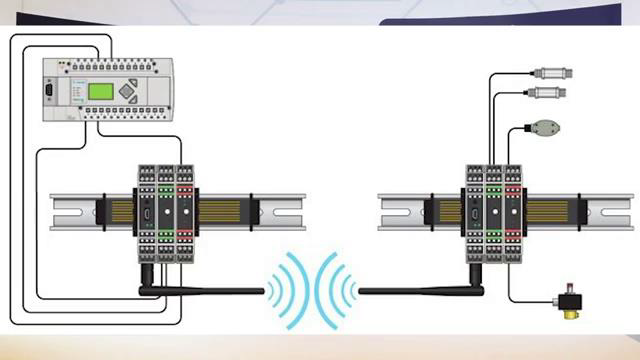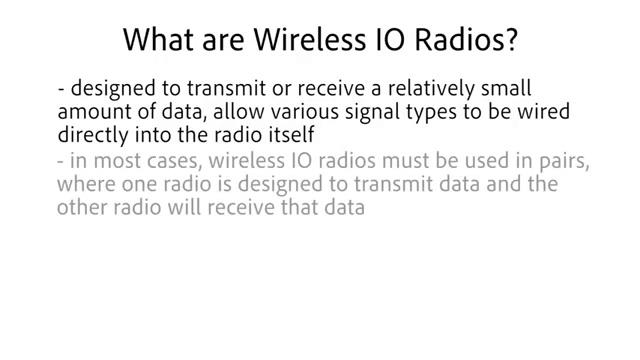Transcript:
[0m:4s] Hi I'm Josh Bloom, welcome to another video in the RSP Supply education series. If you find that these videos are helpful to you, it certainly helps us out if you could give us a big thumbs up and subscribe to our channel.
[0m:16s] In today's video, we are going to talk about a specific type of industrial communication radio and how it can benefit us in applications where transferring data can be a challenge, especially when the distance between two different sites becomes too great to run wire between them.
[0m:37s] I am talking about wireless IO radios.

[0m:41s] These types of radios are different than standard industrial radios, even though they use some of the same communication principles.
[0m:50s] The main purpose of these types of radios is to transmit only a small amount of specific data that is collected by the radio itself
[1m:0s] without the help from any other electrical device, such as a PLC.
[1m:5s] Wireless IO radios are a great solution for situations where only a few signals need to be transmitted over a distance that is too far for wires to be run.

[1m:17s] In this video we will talk about what these radios can do,
[1m:21s] how they work, and in what types of applications they are commonly being used in.
[1m:27s] So let's get started.
[1m:28s] First off, it's important to understand the unlike regular industrial radios that are designed to transmit and receive large amounts of data to and from many different locations, wireless IO radios are designed for a different purpose.
[1m:45s] As mentioned before these types of radios are designed to transmit or receive a relatively small amount of data.
[1m:54s] In many cases, it may be only a few simple signals. These radios are designed to allow for various signal types to be wired directly into the radio itself. For example, you may have a few different analog and digital signals that you need to monitor.
[2m:13s] With a wireless IO radio, you have the ability to connect those signals directly to the radio which it can then transmit that data to another wireless IO radio at a different location.
[2m:27s] One note:
[2m:28s] in most cases, wireless I radios need to be used in pairs where one radio is designed to transmit data., and the other radio will receive that data.

[2m:39s] In some specific cases, specific kinds of wireless IO radios can even provide output functionality which can give the user control over different devices or instruments at remote locations.
[2m:52s] The amount of IO that the radio can handle will vary depending on the type of radio that is purchased. Also, it is important to consider that, unlike a regular industrial radio, wireless IO radios may only be able to either receive or transmit data depending on the brand and model that is being used. But there are some models that can do both.
[3m:15s] These radios are sometimes referred to as wire replacement radios because of the fact that they are so often used in situations where the distance is too far for a wire to be run at a reasonable cost.
[3m:28s] Also, they are a great option because of the ability they have to read signal data directly from the device or instrument without relying on a PLC to communicate the data.
[3m:40s] For example, a common industrial water scenario would include a large water tank in a remote location like on a hill or high in a mountain.
[3m:49s] In some cases, these tanks only have a few signals they need to read such as water level, water pressure, as well as a few other basic pieces of information.
[3m:59s] Instead of installing a PLC at that location to collect that data, and then a radio to communicate it, you can simply install a wireless IO radio to do both. It can eliminate the need for a PLC at that given site.
[4m:15s] There are limitations to these radios as you might expect.
[4m:19s] For instance, the amount of IO that can be used with one of these radios is usually very limited.
[4m:26s] Typically it can only handle a few signals.
[4m:29s] Also, as I mentioned before, in many cases, these radios can only communicate in one direction, which can limit the overall functionality of the radio.
[4m:38s] Before this option is considered for your specific application, make sure you have a solid understanding of how much data is being transferred
[4m:46s] and what you need to do with that data.
[4m:48s] With that said, in certain situations, these types of radios can provide a great solution and very reliable functionality. For a full line of wireless IO radios and other industrial radios as well as thousands of other products. Please go to our website for more information or other educational videos, go to RSPSupply.com, the Internet's top source for industrial hardware. Also, don't forget: like and subscribe.




